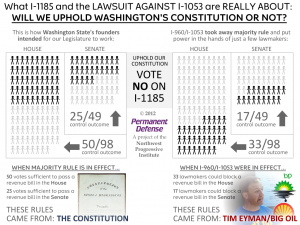September 27th, 2012
Two-thirds is *not* a majority: New pictogram explains what I-1185, lawsuit against I-1053 are really about
From the Campaign TrailIn the CourtsRethinking and Reframing
Today, NPI’s Permanent Defense is releasing a new pictogram that explains what Initiative 1185 and the lawsuit against I-1053 are really about.
Inspired by NPI’s late board member Lynn Allen, the artist and storyteller who created a similar visual for NPI’s 2010 video explaining the cost and consequences of I-1053, the pictogram shows how the two-thirds scheme embraced by Tim Eyman and big oil companies like BP and Royal Dutch Shell is preventing our Legislature from functioning as our founders intended it to.

On the left side of the pictogram is an illustration of what happens when Article II, Section 22 of our state Constitution is in force. Fifty votes (out of ninety-eight total) are sufficient to pass a revenue bill in the House, and twenty-five votes (out of forty-nine total) are sufficient to pass a revenue bill in the Senate.
On the right side of the pictogram is an illustration of what the two-thirds scheme does when it it allowed to illegitimately take precedence over Article II, Section 22. Power is unconstitutionally and undemocratically transferred to a minority – specifically, thirty-three representatives in the House and seventeen senators in the Senate – who gain veto power over the majority.
The words “control outcome” are used in the pictogram to explain who really has power in each situation. When the Legislature operates in accordance with the rules from our Constitution, the majority prevails, because a majority vote is sufficient to pass a bill – even a bill that raises revenue. But when Tim Eyman and Big Oil’s rules are substituted for the Constitution’s rules, control of the outcome passes into the hands of just a few lawmakers, who can override their colleagues.
“This pictogram gives meaning to the adage, ‘A picture is worth a thousand words'”, said NPI founder Andrew Villeneuve. “It is hard to quickly explain to voters the destructive impact that I-960 and I-1053 have had on our state. But this pictogram tells the story, through simple stick figures and easy-to-read fractions.”
“What the pictogram tells us is that above all, this two-thirds scam has sabotaged our plan of government and prevented our Legislature from operating democratically as it always should. It has changed the decision-making process.”
“That has been the most important consequence. The damage isn’t necessarily visible, but it’s there all of the same… beneath the surface.”
“Tim Eyman has a simple slogan he has been using for years, for I-960, for I-1053, and now I-1185: ‘We can’t trust Olympia, so let’s make it tougher for politicians to raise taxes.’ As far as sound bites go, it’s short, but it’s definitely not sweet. The word sour would be a more fitting descriptor. It’s a manipulative sales pitch that reeks of cynicism and improvidence. It should be obvious by now that Eyman thrives on distrust in government; he has an interest in sowing fear, uncertainty, and doubt in people’s minds. It’s good for business.”
“Eyman wants people to think that state government is the problem, so they’ll overlook the fact that his initiative factory is funded by powerful corporations like BP, ConocoPhillips, and Royal Dutch Shell.”
“These corporations want to trample all over our state Constitution so their lobbyists can wield even more power in our state’s capital than they already do.”
“From looking at the pictogram, we can see that requiring a two-thirds vote to raise revenue is not democratic. The phrase ‘two-thirds majority’ is a misnomer because two-thirds is not a majority. It’s a supermajority. And here’s the thing: A supermajority is actually the inverse of a submajority, which even Rob McKenna’s office agrees is not a majority. Requiring a two-thirds vote to raise revenue, in practice, means that just over one-third of the lawmakers of each house control the outcome. They can say no to everybody else.”
It is worth noting that our Constitution itself cannot be altered by majority vote. But that is because it is our highest law. It is the sacred document that protects minority rights. As recent research by Perkins Coie’s David Perez shows, our founders debated where and when to require supermajorities; they knew that in any instance where a higher threshold was put in place, the minority would control the outcome.
The rules they gave us say a constitutional amendment requires a two-thirds vote, but bills require just a majority vote. That way, we have majority rule with minority rights. And by majority vote, our founders meant greater than fifty percent.
No more, no less.
What I-1185 and the lawsuit against I-1053 are really about is this: Will we uphold Washington’s Constitution or not? If we care about the rule of law and the plan of government our founders gave us, we ought to reject I-1185 at the ballot, and our Supreme Court ought to uphold Judge Bruce Heller’s ruling striking down I-1053.


